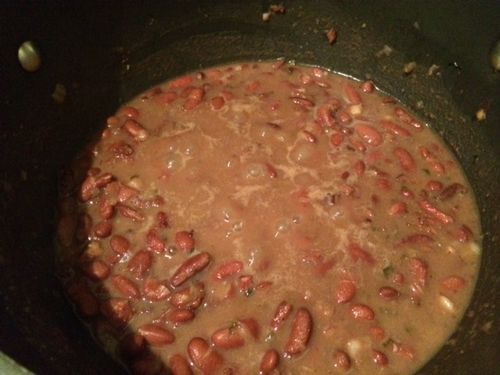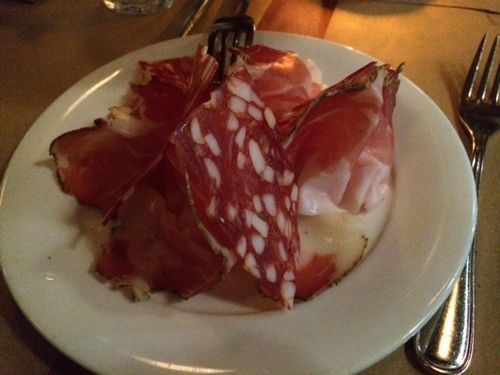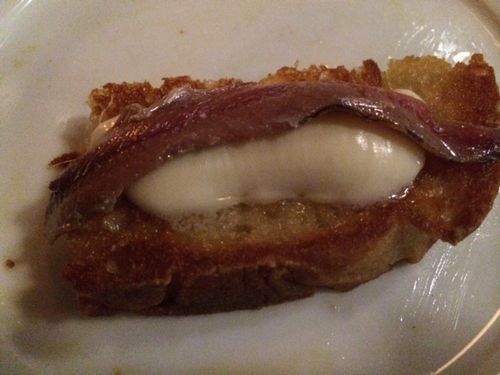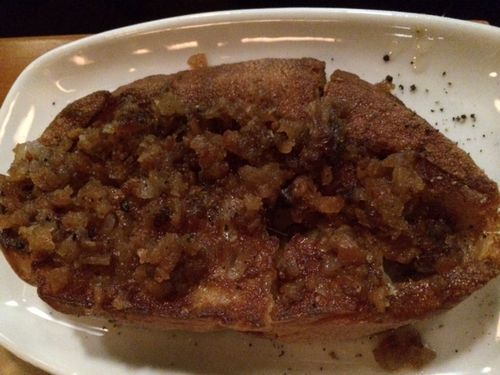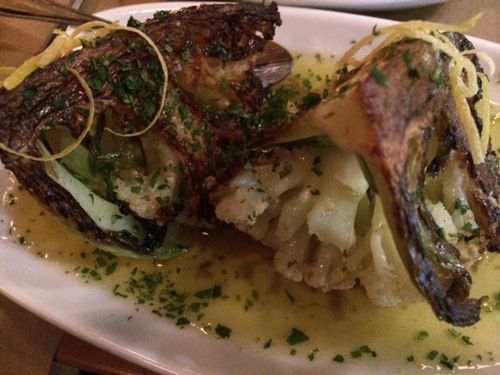Ruth Reichl's Blog, page 15
February 4, 2015
Come on Collards!
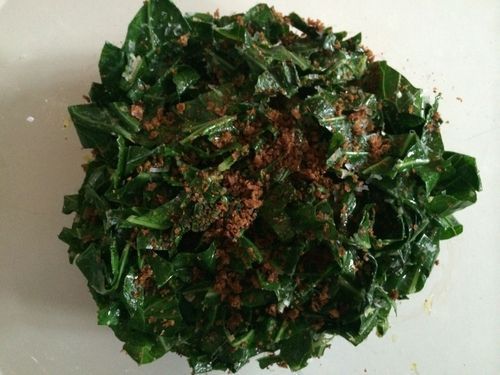
Are you experiencing kale fatigue? Much as I love the stuff, I sometimes think it's time to look at other greens. Yesterday, standing in the produce section, my eye landed on a beautiful—and mammoth—bunch of collard greens. I've always loved their clean, nutty snap, and I decided to take them home.
I had a sudden memory of filming Adventures with Ruth in Brazil, where I learned an amazing way to eat collards. You de-rib each leaf—the stalks are extremely bitter—and then stack each half moon on top of another, 8 or so to a stack. Roll each stack into tight little tubes, and cut into extremely thin ribbons. We julienned them to 1/16 of an inch. Fried in hot oil for a mere ten seconds the result was like savory air that dissolved on the tongue like cotton candy.
This time, I thought, I'd try something different.
I cut the collards into quarter inch strips. Then I sauteed a couple cloves of minced garlic and some chile flakes in olive oil, added the collard ribbons with a bit of salt and pepper, and quickly sautéed until the collards were a brilliant bright green (no more than two minutes).
From here, you need nothing more than the zest of half a lemon and a splash of juice, but I added pickled chiles, some crisp homemade breadcrumbs, and a bit of grated Parmesan. These would probably be delicious with sautéed onion, a little bacon fat and a splash of apple cider vinegar, too.
The possibilities are endless.
This is not exactly a new discovery; we've all been eating collards forever. But kale's been having its moment in the sun, and it's time to make way for collards.
February 1, 2015
Superbowl Sunday Piri Piri Wings
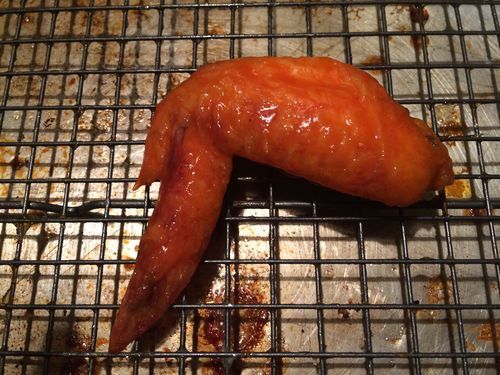
Okay, I'll admit it. I was at Whole Foods the other day, and marinated chicken wings- in about a dozen different permutations - were on sale. I bought their version of Spicy Korean Chicken Wings and brought them home. Put them in the oven, took them out. And threw them right into the garbage.
They were dreadful.
So now I felt compelled to make my own.
This is my version of the classic buffalo wings. Roasted instead of fried - less hassle - and spiced with a more intense sauce.
I apologize for the picture. It's terrible. The wings are not. They are utterly messy, and everything you want in a game-day wing: the sauce, slightly sweet and fiery as hell, gives way to crispy skin.
They're great for the game, but they’d make an equally fine a snack for a movie night.
Baked Piri Piri Wings (Buffalo style)
3 pounds chicken wings, separated at the joint
1 1/4 teaspoon baking soda
1 teaspoon salt
2 egg whites
1/2 stick butter
1 tablespoon brown sugar
1 tablespoon apple cider vinegar
1/2 cup piri piri sauce, preferably Mazi brand
Whisk the baking soda, salt and egg whites together in a large bowl. Add the wings, and coat. Shaking off excess egg white as you go, lay wings on a wire rack set inside a rimmed baking sheet. (I needed two.) This coating helps the skin get crispy and caramel-colored.
Let wings dry in the fridge, uncovered, skin-side up, for at least an hour. (Longer is better; overnight is great.)
Preheat the oven to 450 degrees.
Move wings, still on the racks, directly to the oven. Cook for fifteen minutes, turn over, and cook for another ten. Turn them back to skin-side up and cook for a final ten minutes. The wings should be a nice light brown.
While the wings are cooking, make your sauce. Melt the butter with the sugar in a small saucepan. Turn off the flame. Add the piri piri sauce and vinegar. Taste and adjust seasoning as you see fit.
When the wings are done cooking, let them sit for at least five minutes. Then toss, madly, with the sauce. Serve immediately, with celery stalks - and blue cheese if you're so inclined. (An homage to the Anchor Bar.)
January 30, 2015
Do the Beans Matter?
Stopped in at The Little Jewel of New Orleans Grocery and Deli today, to get some gumbo to go. It may be one of L.A.'s best bargains- a really righteous bowl of gumbo, a side of rice, along with toast and butter for about ten bucks. A fantastic dinner.
Haven't tried anything else here, although I'm thinking those muffalettas would be perfect Super Bowl fare, and I did bring some boudin blanc home for a midnight snack. I'm pretty sure this is the real thing - proprietor and chef Marcus Christiana-Beniger can really cook. Can't wait to try the po' boys, although frankly I can't imagine there's anything here I wouldn't like.
We wandered through the aisles of the shop, looking at all those classic New Orleans products. Laurie picked up a package of kidney beans and said, "These are the right kind of beans for red beans and rice. You should buy some." I thought - do beans really make that much of a difference? Still, I bought some. They weren't cheap; a pound of beans cost half what the gumbo did. It was the same price as the boudin. Five bucks a pound: pretty pricey beans.
But they were absolutely worth it.
Came home and followed the directions on the package.
It probably helped that I had some Snake River Farms Kurobata Ham to use for what the package calls "seasoning meat." But I'm guessing it didn't help all that much. It was the Camellia Kidneys that made this the most satisfying pot of beans I've ever cooked.
I will never again be without them. The beans smelled fantastic while they were cooking. They tasted great with rice. And they went up against that gumbo. Didn't win. But weren't embarrassed.
Cajun Red Beans
1/2 pound Camellia Red Kidney Beans
4 cups water
1/4 pound ham or "seasoning meat," diced
1/2 onion, diced
1 garlic "toe"
1/2 stalk of celery, chopped
handful of chopped parsley
1 bay leaf
salt, pepper
Wash the beans and sort through them. Put them in a pot with the water and bring to boil. Turn down to a simmer.
Put the ham into a skillet and cook until it's given up its fat. Add the onion, garlic, celery and parsley, and cook until the vegetables are soft and fragrant. Add this to the beans.
Toss in the bay leaf and a fair amount of salt and pepper.
Simmer, covered, for an hour and a half or two, until the beans are soft. Take a spoon and smash some of the beans against the side of the pot to thicken and make the beans creamy.
Serve with rice and Cajun hot sauce to 4 very happy people.
January 29, 2015
Notes from Chi Spacca
That's Nancy Silverton, serving the focaccia di Recco at Chi Spacca, which may be the most irresistible thing I've eaten this year.
Think crisp, paper thin layers of dough. Rich stretchy cheese. Olive oil. Salt. The play of textures is arresting - you focus on the amazing things happening in your mouth - and then you just stop thinking altogether and succumb to the sheer deliciousness of the dish.
Chi Spacca is famous for its meat. Among other things, Chad Colby's homemade salume (I'm especially partial to the culatello):
but I decided to focus on dishes other than the giant tomahawk pork chop, the gonzo meat pie, the fabulously expensive bistecca alla fiorentina that everyone is always rhapsodizing over.
So we began with these incredible little crostone of anchovies and butter. Is there anything better than the saline tang of really good anchovies tamed with sweet butter?
Then this ode to the middle ages, when the rich ate their meat on trenchers of bread, and then donated the bread to the poor. If it tasted anything like this drippings-soaked toast, well, count me in. I suspect we'll be seeing copies of this soon. (In a further ode to the lore of the trencher, this is also the least expensive dish on the menu.)
And then there is this chicken, a version of pollo alla diavolo that relies more on lemon than chiles. The chicken itself is pretty perfect - crisp and moist, juicy and flavorful - and there's that trencher again, soaking up all the juices.
And did I mention the cauliflower? It's the vegetable of the moment, taking over from kale, and Spacca does a very satisfying version:
January 27, 2015
Eating Words
There are too many food blogs. We all know that; it's impossible to keep up.
But I've just stumbled on another one that's really worth the time.
Paper and Salt examines the favorite foods of literary icons, which is, of course, a whole new way to get to know your favorite authors. It's a fascinating look at writers as diverse as Hunter S. Thompson, the Marquis de Sade, Edith Wharton... the list goes on and on.
Consider, for example, Mary Shelley. Would you expect the creator of Frankenstein to offer you a recipe for what is essentially a kale bruschetta topped with a fried egg? (She considered it comfort food.)
And I will certainly never be able to think of Les Miserables without remembering that "Visitors to the Hugo family table remarked on the multiple cups of hot cocoa in the morning, and the “enormous pieces of roast meat” in the evening.” Hugo also ate lobsters (shell on), oranges dunked in wine, (rind on), and during the blockade of the siege of Paris he took advantage of the zoo’s liquidation of stag, antelope and bear. (The recipe included with this post, venison with blackberry sauce, is mercifully tame.)
To see another way that food and culture inform each other, look no further than a post on Catharine Beecher. Her recipe for peanut brittle appears in Miss Beecher’s Domestic Receipt-Book. Although Beecher calls the brittle “molasses candy,” she warns against using cane sugar because it was, at the time, a product of slave labor. She recommends substituting maple syrup; her sister, Harriet Beecher Stowe, would surely have approved.
January 23, 2015
Pop Up!
I can't resist antique kitchen utensils, which is why I have so many cast iron pots. Lately I've been looking for a copper egg white bowl because I have a strong urge to make zabaglione. But my most recent find here in my rented kitchen in LA was this little beauty: a well-seasoned iron popover pan.
Popovers are descended from Yorkshire Pudding; the first recorded recipe appeared in 1737 in The Whole Duty of a Woman where it was known as “ A Dripping Pudding.” Eight years later in The Art of Cookery Made Plain and Easy, Hannah Glasse renamed it Yorkshire Pudding; nobody knows why. (The usually reliable Mrs Beeton, incidentally, got the recipe wrong.) Buckeye Cookery, a mid-American cookbook first published in 1877 contains two recipes for “Pop-Overs” which are, essentially, Yorkshire Pudding without the drippings.
Whatever you call them, popovers are one of the most satisfying recipes you can make. You put a very modest batter into the oven in a greased hot pan where it explodes; when you open the oven door your popovers will have grown to as much as six inches tall.
I've tweaked this recipe from an original in Fanny Farmer. The real secret to a fine popover is making sure your pan is piping hot when you batter it up.
If you have meat drippings, be sure to add them; that way you'll end up with Dripping Puddings. Such a great name!
Brown Butter Popovers
3 eggs
1 cup whole milk
1/2 teaspoon salt
1 cup flour
5 tablespoons butter, browned
a couple more tablespoons butter for the pans
Gently beat the eggs and milk just until they're blended. Whisk in the salt, then the flour, pouring in a thin stream and continually whisking as you pour.
Let batter rest for a bit. If your batter is too cold when it hits the oven, your popovers will be less impressive.
Preheat the oven to 425 degrees, and set your pan inside.
Meanwhile, melt the butter on low heat, allowing it to cook until a wonderfully nutty aroma rises up. When that happens, immediately remove it from the fire. Add browned butter to the batter. (It may coagulate; that’s fine.)
Remove the hot pan from the oven. Working quickly, drop a bit of butter into each cup and swoosh it around. Add your batter. This recipe will fill a true 6-cup popover pan, or a 12-cup regular muffin pan.
Cook for 30 minutes, or until brown and set. (Less if you used a regular muffin pan.) Try not to open the oven to check doneness more than once; the cool air rushing in will deflate the popovers.
January 22, 2015
Great, Easy Appetizer to Please a Crowd
Poor Man’s Tarte Flambée
This was a big favorite at Gourmet, but around our house it’s known as “Robert’s Cheese Toast” because my friend Robert likes it so much. The truth is, everybody I know loves this old-fashioned American classic, and no matter how much I make, it vanishes in a flash. Which is why there is no photograph: every drop had disappeared before I thought to get out my camera.
Coarsely grate or chop a quarter pound of extra-sharp white cheddar. Chop a quarter pound of cold uncooked bacon and mix it in with the cheddar. Mince half a small white onion and add that, along with a tablespoon of well drained bottled horseradish. Sprinkle in a quarter teaspoon of salt and a few good grinds of black pepper.
Spread this onto 6 or 7 slices of thin white bread (Pepperidge Farm is perfect), set them on a baking sheet and freeze for 15 minutes.
Cut off the crusts and then cut each toast in quarters. Bake in a preheated 375 degree oven for 20 minutes or so, until everything has melted into a delicious golden goo.
This is enough for 4 or 5 people.
January 20, 2015
Sholeh Zard
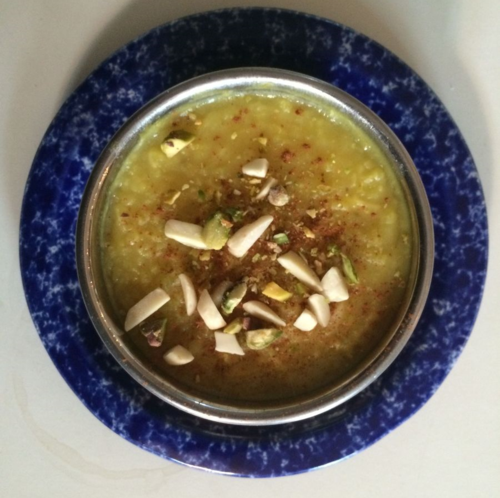
Sunny Buttery Saffron Rice Pudding
Rice pudding is the chicken soup of desserts. Ultimate comfort food, it's an international dish that changes its style as it travels the world.
Once again perusing my stack of Time-Life books I came upon another recipe I couldn’t resist: sholeh-zard, or Persian saffron rice pudding. A goldenrod smear on the page suggests I once made this, but I have no memory of it.
Intrigued by the saffron - and the fact that this rice pudding contains no milk - I decided to try it. Unlike the two previous recipes I’ve written about here, this one was so sweet and so strongly redolent of rose water that I made a few serious modifications. Trolling around on the internet I found that sholeh-zard is traditionally incredibly sweet; one recipe I found called for three cups of sugar to one cup of rice. And the classic version is so strongly perfumed with rosewater that some recipes call for as much as a cup. But I've made this to my own taste, so it's less sweet and less perfumed.
It is also, in my opinion, very delicious.
Sholeh-Zard
Serves 12
2 quarts water
1 cup basmati or Iranian rice, rinsed and soaked
1/4 teaspoon salt
1 cup sugar
8 tablespoons butter, cut into 1/2 inch pieces
1 1/2 teaspoons saffron threads, pulverized with a mortar and pestle or the back of a spoon, and dissolved in 1 tablespoon water
1-3 tablespoons rose water
6 tablespoons slivered blanched almonds
4 tablespoons slivered or finely chopped unsalted pistachios
1 teaspoon cinnamon (garnish)
In a heavy 4-5 quart saucepan, bring the water to a boil over high heat. Pour in the rice and salt and stir. Reduce the heat to the lowest possible point and simmer uncovered for 30 minutes. The rice will still be quite watery. Stir in the sugar, then add the butter and the saffron mixture and continue stirring over low heat until the sugar has dissolved, the butter has melted, and the rice is bright yellow. Stir in the slivered almonds, and 1 tablespoon of the pistachios and, stirring occasionally, cook for 30 minutes longer until the mixture is thick enough to hold its shape almost solidly in the spoon.
Stir in the rose water according to taste. Ladle into a bowl or several small ramekins. Let cool at room temperature, and then refrigerate for at least two hours. Traditionally, this pudding is decorated with lines of cinnamon and nuts laid out in your own personal design.
January 17, 2015
LP
A Great New Site You Want to Know About
As you probably know, I'm very partial to Cherry Bombe, the beautiful food magazine that celebrates women and food. It's the counterpoint to Lucky Peach, the gonzo food magazine whose every issue teems with kooky art, pages-long recipes for classic delicacies (stag pizzle soup anyone?), and a long meaty read or two.
In the seventies, both of these would have been niche magazines, fiendishly passed around NY's fine dining kitchens. But in today’s food-obsessed universe they’re the troubadours for a generation of savvy, irreverent gourmands. And now Lucky Peach has just launched a real-deal website. Lucky us.
The site is as intelligently done as the rest of the magazine. Take a look at the Atlas section, where contributors like David Chang recommend their favorite restaurants around the world. The list is small, but if our luck holds this will evolve into an enlightened alternative to Yelp.
In the features section I'm very partial to Brette Warshaw’s NYC Ramen survey, Slurp & the City; this is a voice to be reckoned with. There’s also enough of the magazine’s archives up there to steal your afternoon. Another favorite: Peter Meehan on Claudia Fleming.
January 15, 2015
Another One from the Time-Life Series
Flipping through my Time-Life cookbooks is like stepping into a temperamental time machine. Some food-splotched recipes ring no bells, while others summon memories so vivid I can literally smell them. How many times did I make that manicotti, and for how many people? Suddenly I’m lugging it up the rickety steps of an abandoned building on Stanton Street that a friend once called home, still warm from my oven. There was only one fork for every two people that night - which made the manicotti taste even better.
It’s been a long time since I’ve made the ghobi sabzi (curried cauliflower) below. As I was cooking, I tried to predict what I would think of the flavor. Would it seem blandly familiar, like a robust curry that had been flattened to suit a mainstream American palette from the sixties?
Just the opposite. This dish may not be entirely authentic, but it really sings. With the exception of the black mustard seeds, you probably have the ingredients in your cupboard right now. It's easy to make and utterly delicious--comforting, richly spiced, perfectly balanced. I moved onto a second bowl almost immediately after finishing the first.
Gobhi Sabzi (Adapted from The Cooking of India )
1/3 cup vegetable oil
1/2 teaspoon black mustard seeds
1/2 teaspoon cumin seeds
1 tablespoon scraped, finely chopped fresh ginger
1/2 cup finely chopped onions
3/4 teaspoon salt
1/2 teaspoon turmeric
1 head cauliflower, washed, trimmed, divided into small flowerets, and dried thoroughly
1 small ripe tomato, washed, cored and finely chopped
1 fresh jalapeño or serrano, washed, seeded and finely chopped
1/2 teaspoon ground cumin
1/2 teaspoon sugar
2 tablespoons chopped cilantro
1 tablespoon ghee, melted (clarified butter)
In a heavy bottomed saucepan, heat the vegetable oil over moderate heat until a light haze forms above it. Stir in the mustard seeds, cumin seeds, ginger and onions. Cook, stirring constantly, for 1 minute, add the salt and turmeric, and continue stirring for 3 or 4 minutes.
Drop in the cauliflower and turn the flowerets about with a spoon until they are evenly coated with the onion mixture. Then stir in the tomato, chili, ground cumin, sugar. Reduce the heat to medium low, and stirring occasionally, cook over moderate heat until the cauliflower is tender but still intact, 10-15 minutes.
To serve, transfer to a bowl, and sprinkle with cilantro and ghee.
Ruth Reichl's Blog
- Ruth Reichl's profile
- 2980 followers



